How to Publish a Poetry Book: Guide to Publishing and Promoting Your Poems
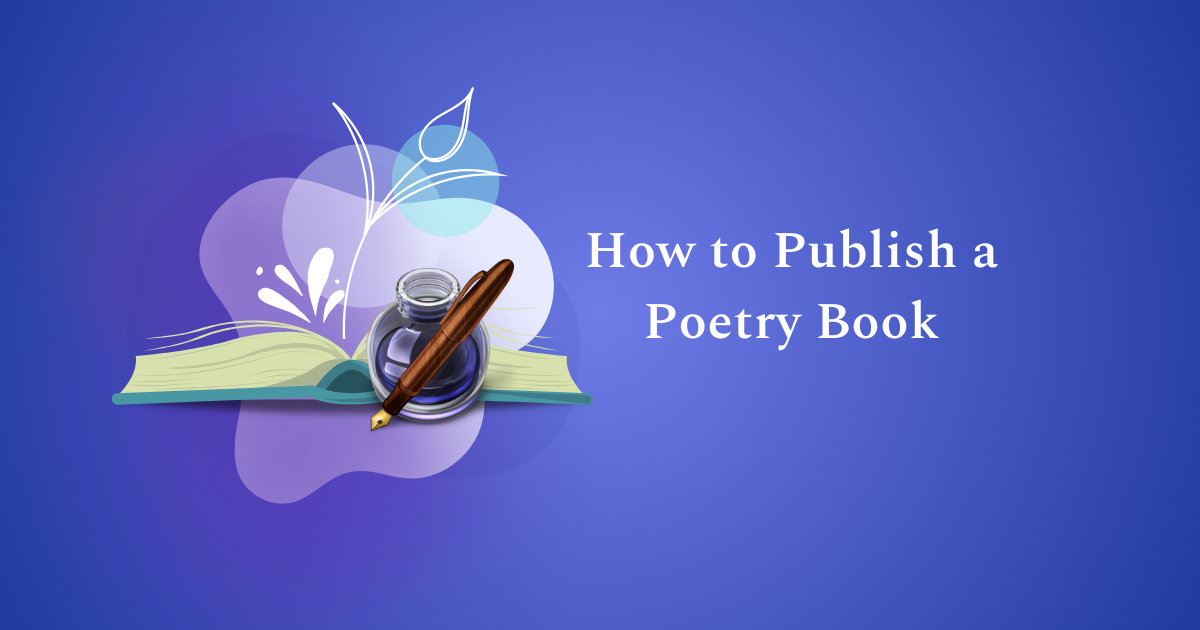
Poetry has the power to make us see the world in new and beautiful ways. If you're an avid reader of poetry books or you've seen Dead Poets Society, you know what I'm talking about. "We don't read and write poetry because it's cute. We read and write poetry because we are members of the human race. And the human race is filled with passion. And medicine, law, business, engineering, these are noble pursuits and necessary to sustain life. But poetry, beauty, romance, love, these are what we stay alive for" – as John Keating said.
If you're a poet looking to share your work with the world, self-publishing poetry can be an incredibly rewarding experience.
In this blog post, I go over:
Poetry Book Publishing Trends
A study from National Literacy Trust shows that engagement with poetry is associated with positive literacy behaviors, plus some other relevant data.
Here’s what they found about children and young people as readers of poetry:
- In 2022, 3 in 10 (28.0%) children and young people read poetry at least once a month in their free time.
- 35.3% of children and young people read poetry at least once a month in 2022 compared with 2010 (increasing from 20.7% in 2010 to 28.0% in 2022).
- More girls than boys read poetry in their free time (31.6% vs. 20.4%).
- Compared with those who do not read poetry, more children who read poetry said that they enjoy reading (62.3% vs. 42.0%), read daily (37.7% vs. 24.3%), and see themselves as good readers (85.5% vs. 78.2%).
- Most poetry readers were motivated to read poetry to learn new words (67.6%), new things (65.8%), or about other people and cultures (51.8%).
- 1 in 2 (50.9%) children and young people who read poetry in their free time write poetry in their free time. 7.1% of children who don’t read poetry don’t write poetry either.
The same study showcases a few publishing trends about children and young people as writers of poetry:
- Nearly 1 in 5 (18.5%) children and young people write poetry in their free time at least once a month.
- More girls than boys write poetry in their free time (22.0% vs. 14.3%).
- Compared with those who do not read poetry, twice as many enjoy writing (59.1% vs. 29.1%). More of those who wrote poetry wrote daily (27.9% vs. 15.6%) and saw themselves as good writers (80.4% vs. 66.7%).
- Most poetry writers wrote to express their creativity (74.0%) and imagination (67.8%) or to relax (57.4%). Around 1 in 3 wrote poetry to feel connected to the world (35.7%) or to support causes they care about (31.1%).
There’s also a study from Wordsrated that tells us which format readers prefer when it comes to poetry:
- 29.3% of poetry readers read poetry only in print books.
- 28.2% of poetry readers use only ebooks to read poetry.
- 9.9% of people only listen to poetry in audio format.
- 32.6% of people use digital channels, ebooks, and audio, to read poetry.
- Poetry readers are among the most digital-friendly book readers; more than 70.7% don’t buy print books to read poetry.
Why Was Poetry Always a Relevant Genre?
Poetry is a medium used by many to express their feelings or struggles or to try to grasp the world around them.
You’ll often find these themes in the poetry industry:
- Social Issues: While focusing on different themes, some poets address and comment on political and social issues, from war and poverty to discrimination and inequality. Short verses written by Insta Poets (more about them in a minute) have been used on multiple occasions to further social change.
- Love: This is the most common theme in poetry. Poets write about the different kinds of love: romantic, familial, and platonic.
- Nature: Another common theme in poetry–the beauty of the natural world.
- Mortality: Many poets explore the idea of mortality and the fleeting nature of life.
- Spirituality: You’ll often see poems showing their authors' beliefs, faith, doubts, and the meaning of life.
- Self-discovery: Poets explore their own self-discovery journey through verses. They question their identity and their place in the world.
- Aesthetics: Ultimately, poetry is a form of art. That’s why many poets choose to talk about the beauty they see in the world or even in the most common of places.
Besides the common themes that are relatable to everyone, there’s the short format that makes poetry so popular among readers.
What to Do Before Self-Publishing a Poetry Book
1. Join online communities and share your poems there
Before publishing your book, it’s worth building an online presence and sharing some of your poems with your audience.
Amanda Lovelace made history in 2016 when her self-published book the princess saves herself in this one won The Goodreads Choice Award. In that year, she was the only self-published author winning an award (out of 400 nominees), and in that month alone, the book was shelved (chosen as to-be-read or favorite in a category on Goodreads) by readers 2800 times.
Jane Friedman interviewed Amanda Lovelace on her success and how she used booklr (one of the main literary communities on Tumblr) to make her poems get noticed: “I made myself known in the booklr community for being an open and honest book blogger, and later, as a cautiously hopeful writer. Thus, when I announced the existence of my poetry collection, I didn’t have to proactively contact any book bloggers to promote it—booklr was ready to support me from the get-go.”
Although it happened a few years ago, Lovelace’s experience is still relevant today. Word-of-mouth marketing is a powerful tool to use for book promotion.
If you want to join an online community, here’s what you can do:
- Use multiple social media platforms and post to all of them to test which one fits your style the best. Don’t be afraid to try new platforms and formats, as the social media landscape is very volatile–platforms come and go out of style. Moreover, each of these sites provides different formats to share your poems. Experiment to learn which one suits you.
- Join a community on social media only if you’ll comment on others’ work as well. These sites are communities. You are not there only to promote your work but to help others with their own. As Lovelace said in the same interview: “The communities we become integral parts of genuinely want to see us succeed. In that way, the community is much more powerful than any paid ad you can ever run.”
- Post frequently. Whether it is your poems that you are sharing or some snippets of your writing life, these posts will pave the way to gathering loyal readers and friends in the online literary community.
Now, let’s see some of the social media platforms you can join to build an audience.
I’ll start the list with Instagram, as it may be one of the best places to post your poems before and after officially publishing them.
Instagram is a place where you can post your poems in a creative way. Users love to see words placed on eye-catching visuals, and many Insta Poets follow this trend. Besides, you can join #bookstagram and post your Instapoetry to get noticed in that community of authors.
💡What is Instapoetry? It’s a form of poetry that started on Instagram. Instapoetry is characterized by short, simple, and easily digestible poems that often incorporate visual elements like line breaks and imagery.
Wordsrated has a few stats about Instagram and Instapoetry:
- In 2017 and 2018, Instapoetry was the reason behind the rise in poetry books’ popularity in the US.
- In 2019, 7 of the top 20 Amazon best-selling poetry books were written by Instapoets.
- Instapoetry is very popular in Canada, where Instapoets make the most poetry book sales.
- In 2017, 80% of all poetry books sold in Canada were written by Instapoets; in 2018, they accounted for over 70% of all poetry sales.
- In 2020, over 49% of all poetry sales were from Instapoets.
Let’s see some examples of Instagram Poets and their accounts to inspire you.
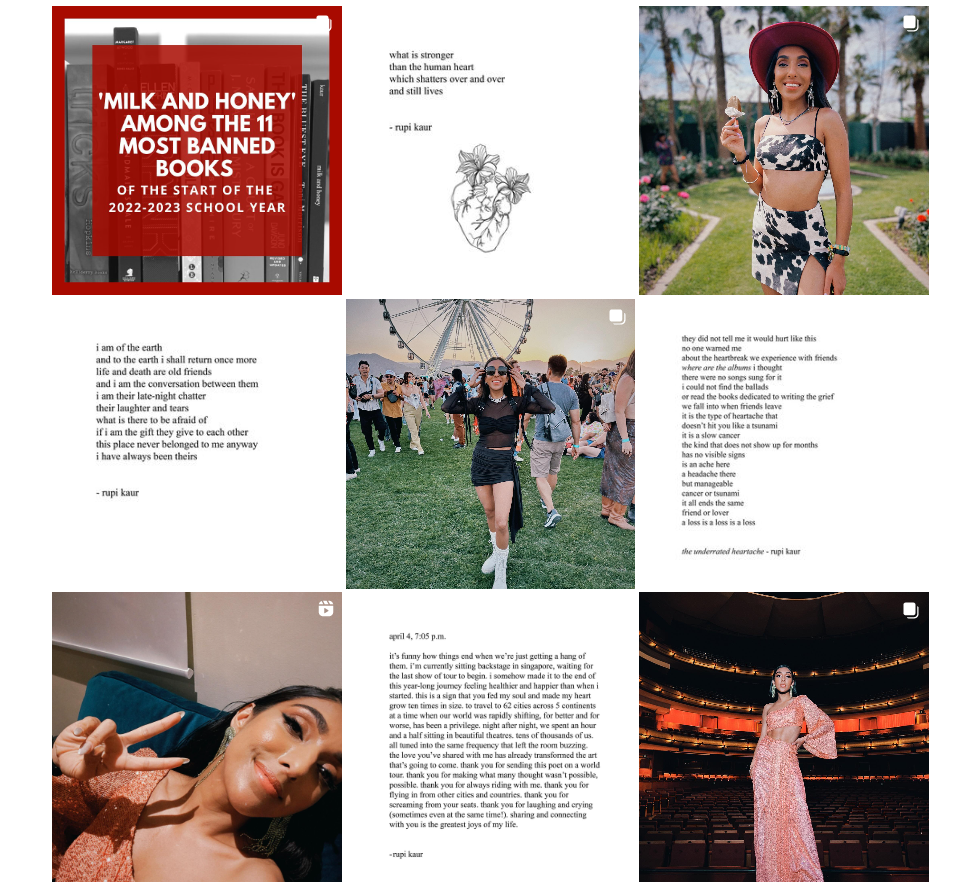
If you go to Rupi Kaur’s account, you’ll see she combines Instagram poetry with snippets of her life, which makes her Instagram account not only a pleasure to explore but also one to be admired for its aesthetics.
She’s one of the poets that helped the Instagram poetry movement gain popularity. She started her career by posting her work on Tumblr in 2012 and then gradually switched to Instagram. This helped her when she decided to self-publish her first poetry book.
“I was broke. I was a student, and I published Milk and Honey with like zero dollars ‘cause I was able to design, write and edit all of it. This is what I did when I was supposed to be studying for all of my exams.” said the bestselling poet, Rupi Kaur, in an interview with Jimmy Fallon.
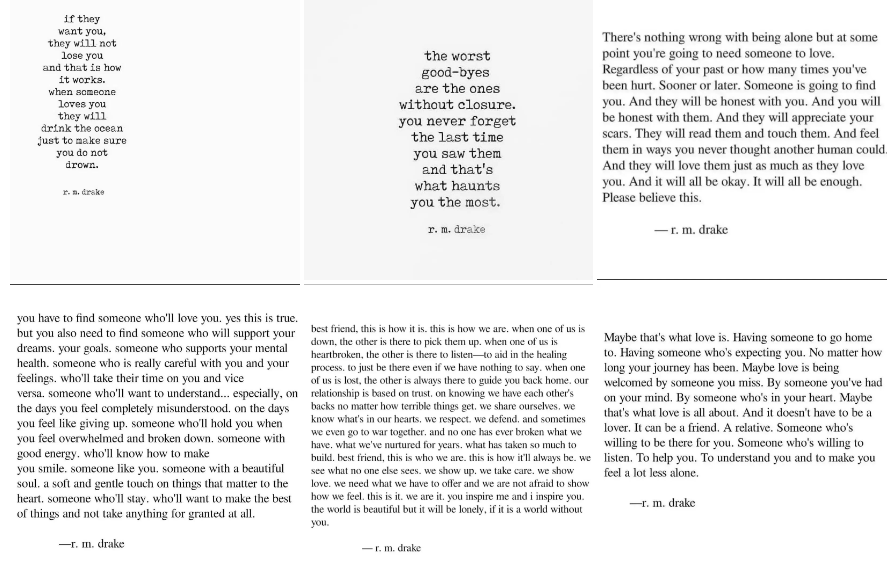
Robert M. Drake (also R.M. Drake) is the pen name of American poet, novelist, and visual artist Robert Macias. On his account, you’ll find Insta poems and his thoughts that together create an Insta poet’s account you wish to keep on scrolling.
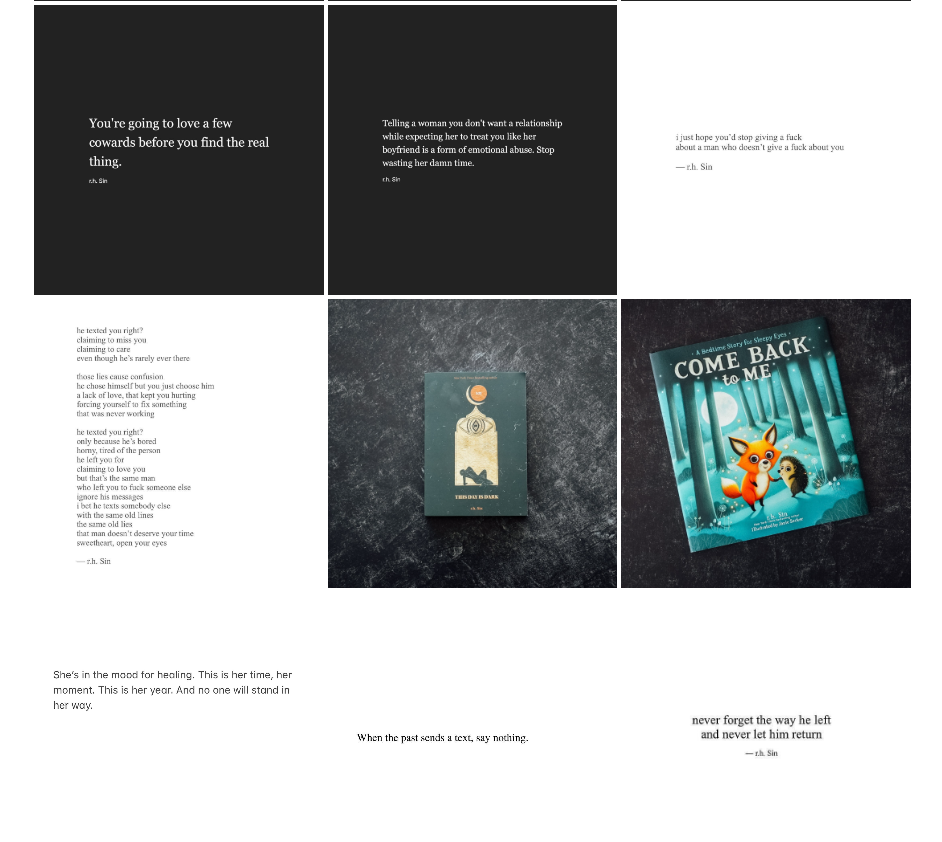
r.h. Sin is an NYT Best Selling Author and an Instagram poet who, through his poems, wants to “help you let go of unhealthy relationships.”
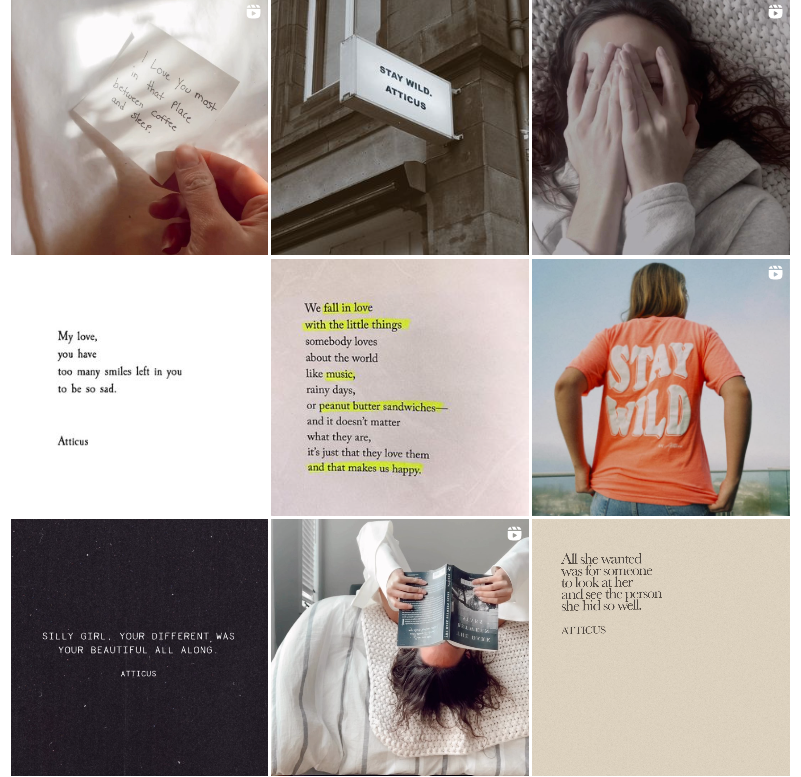
Atticus is another published poet and a three times NYT Bestselling Author, but they chose to remain anonymous. If you go to their Instagram poetry page, you’ll see a collection of beautiful poems and visuals.
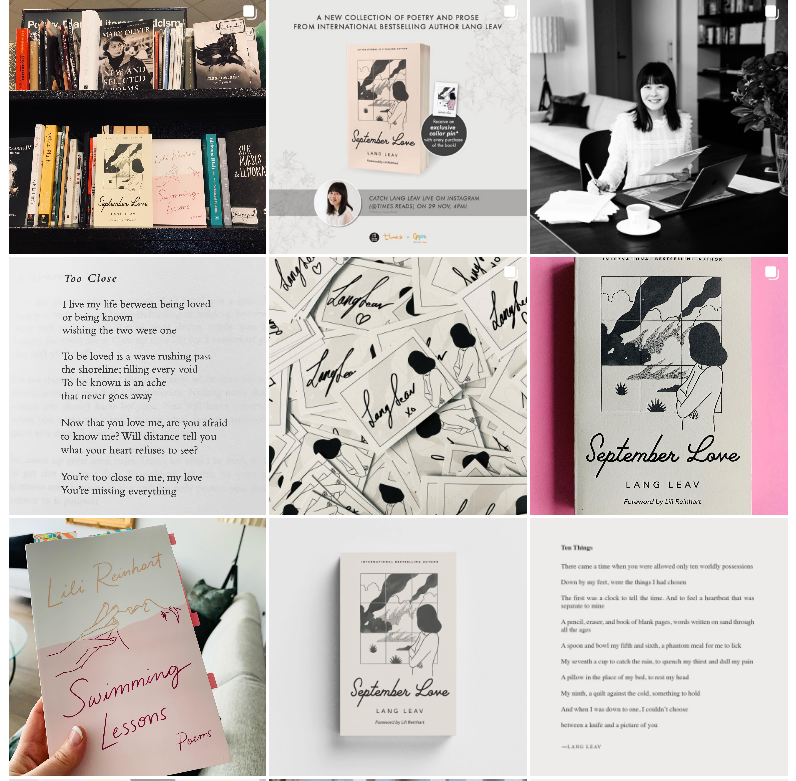
This one’s another delight wrapped as an Instapoetry page. Lang Leav is an International Bestselling Author and an Insta poet that takes us on a journey of perfectly woven words and visuals.
Christopher Poindexter is an Insta poet that posts pictures of his published poems. To make it aesthetically pleasing, his Insta poem images are mixed with photos of his books or personal life.
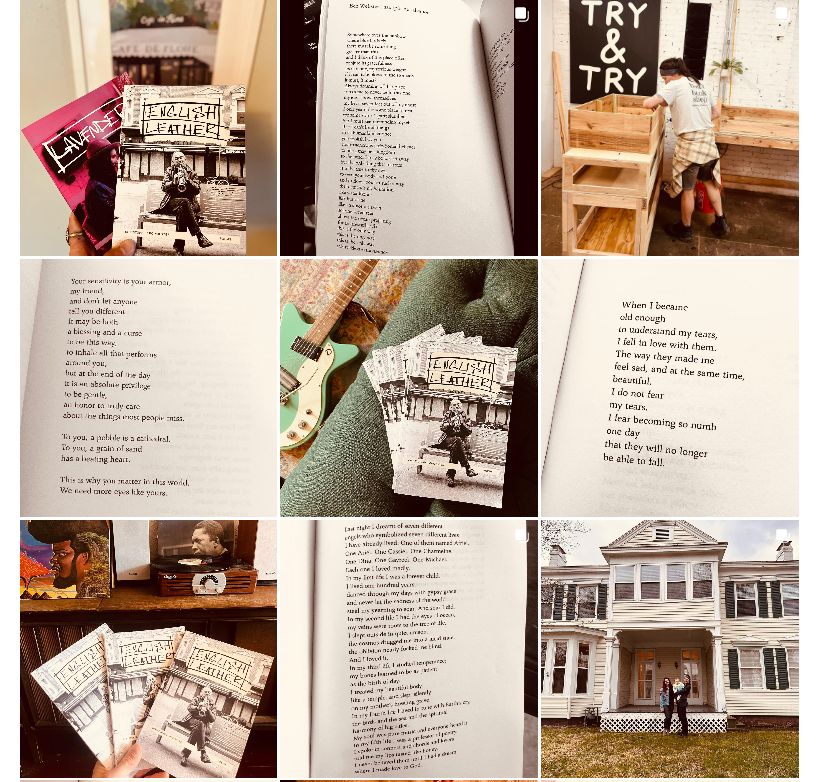
If you pay attention to how you edit your posts of poetry on Instagram, the images become art, enhancing the meaning of the poems.
Posting on Instagram can help you see how people react to your poems. In this way, you can get feedback on whether readers will buy your book after you publish it.
TikTok
TikTok is another social media platform that authors can use to promote their poems.
As a video-focused platform, TikTok might not come so easily for some poets, as not everyone feels comfortable sharing videos of themselves. But there’s a solution to this.
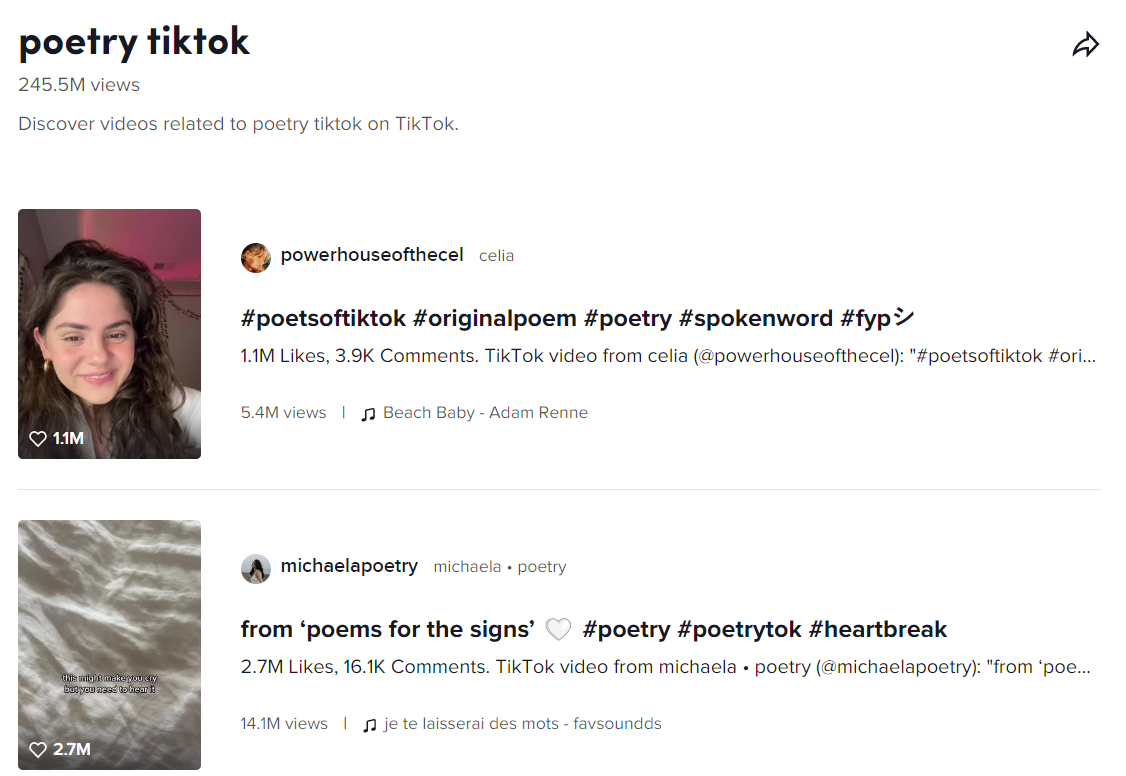
On TikTok, you can post about your poetry in two ways. Only text with visuals, but also you reciting your poems.
Here are some examples of TikTok poetry profiles:
If you go to this TikTok profile, you’ll see that all the poems are joined by visuals:
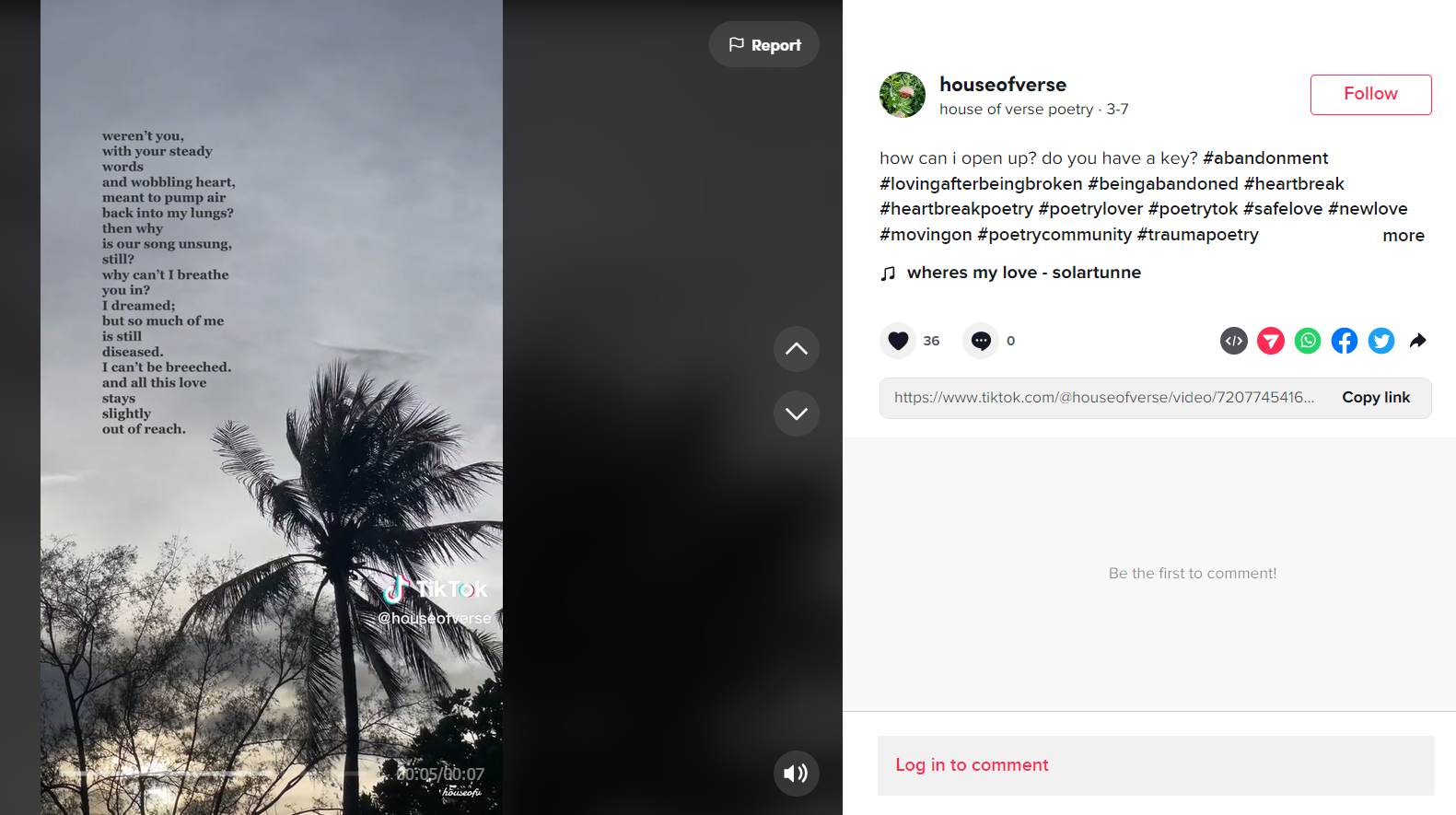
On the other hand, this poetry TikTok account is with the author reciting poems.
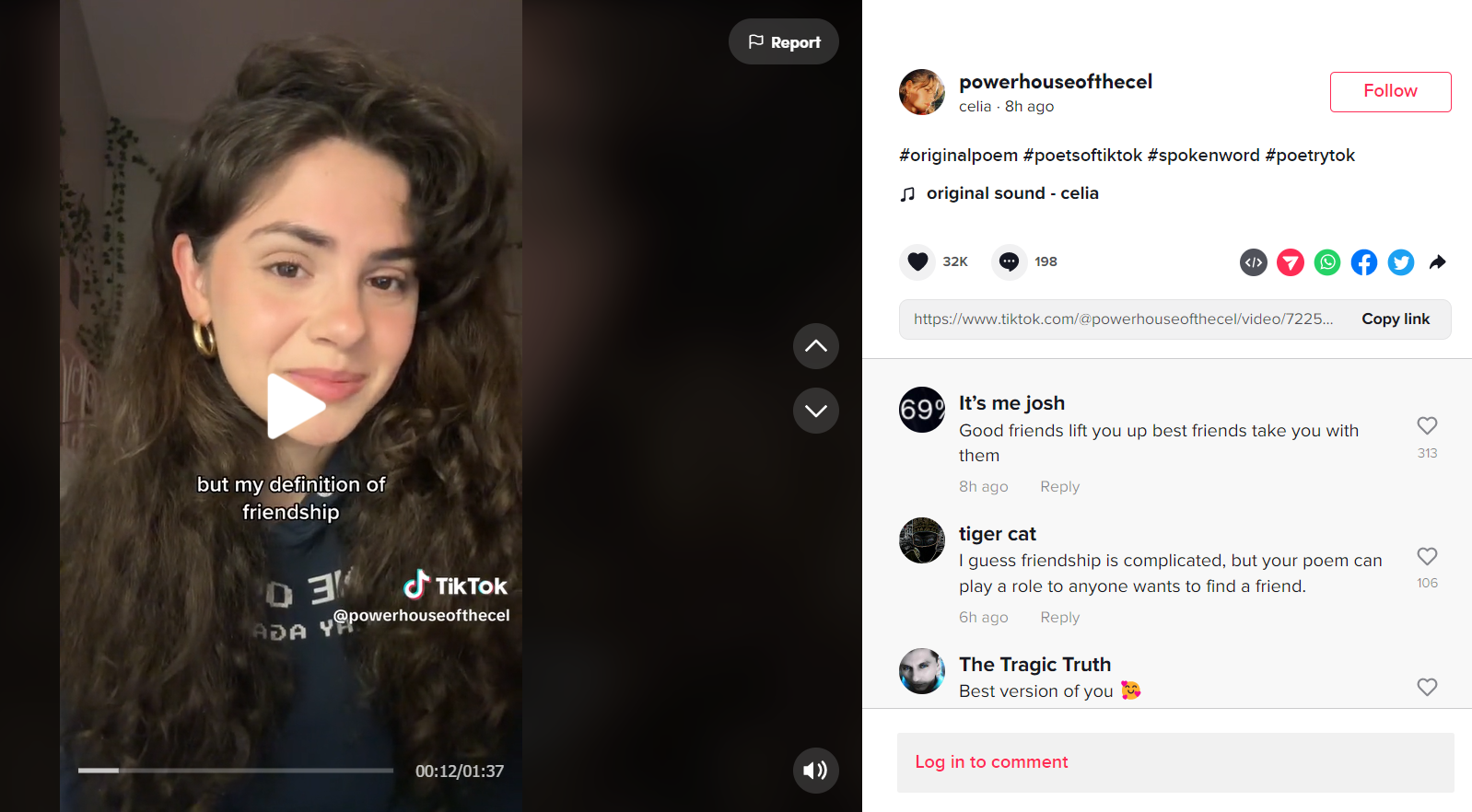
Here are a few tips to get you started:
- Keep it short and sweet: TikTok is known for its short-form videos.
- Use visuals to enhance your poetry: TikTok is a visual platform, so use visuals in your poetry videos.
- Use popular hashtags: Like any social media platform, using relevant hashtags can help your content reach a wider audience. Look for popular poetry-related hashtags on TikTok, such as #poetry, #spokenword, #poetrycommunity, #poetsoftiktok, #poetrytiktok, and #tiktok_poetry, #booktok, and others.
- Collaborate with other creators: Consider collaborating with other TikTok creators, such as musicians or visual artists, to enhance your poetry videos and reach a wider audience.
- Engage with your audience: Don't forget to respond to comments and create content that encourages interaction.
Tumblr
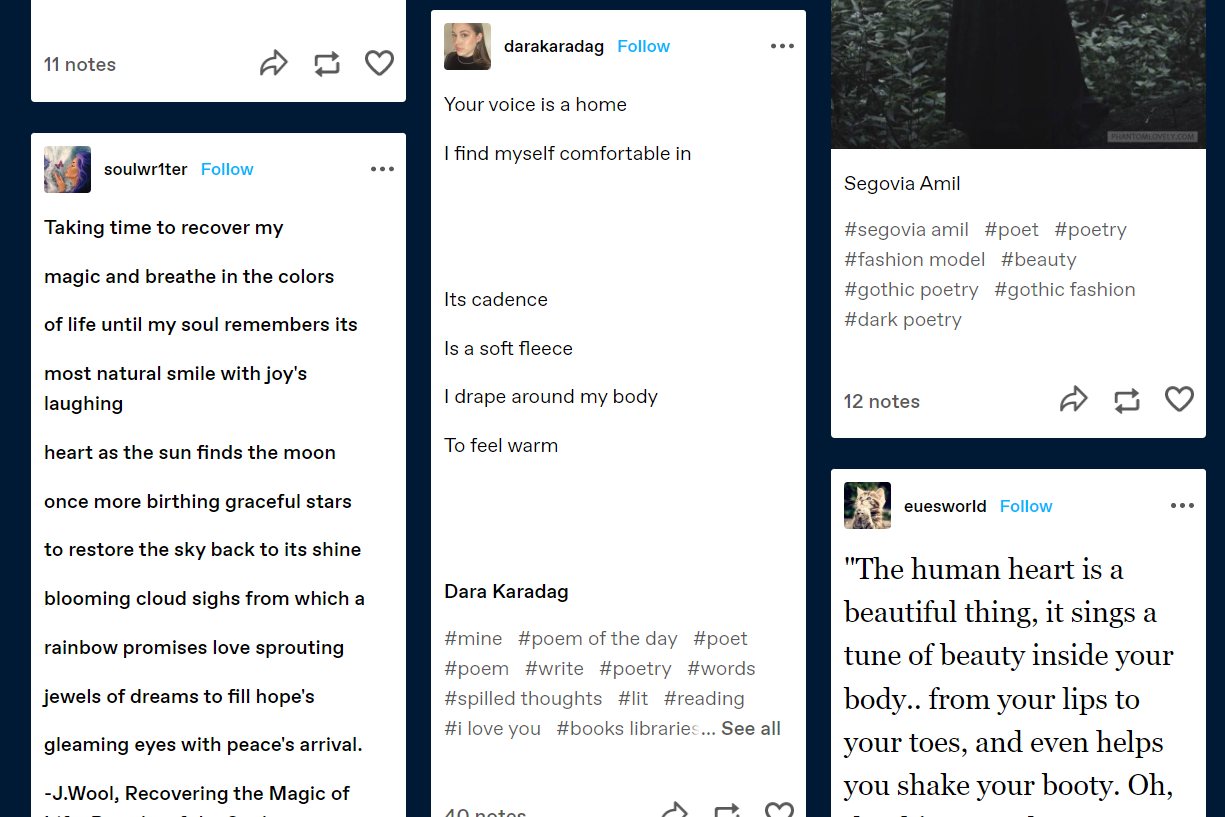
Tumblr is great for beginners, and it can build up to great marketing for poetry books, mostly because its tagging system for poets has been built up quite nicely over the years. Tags like #poetry, #poemoftheday, #poetsoftumblr, and #typewriterpoetry will ensure that a greater audience can find your work.
On Tumblr, people often follow certain tags to discover new poets.
Commaful
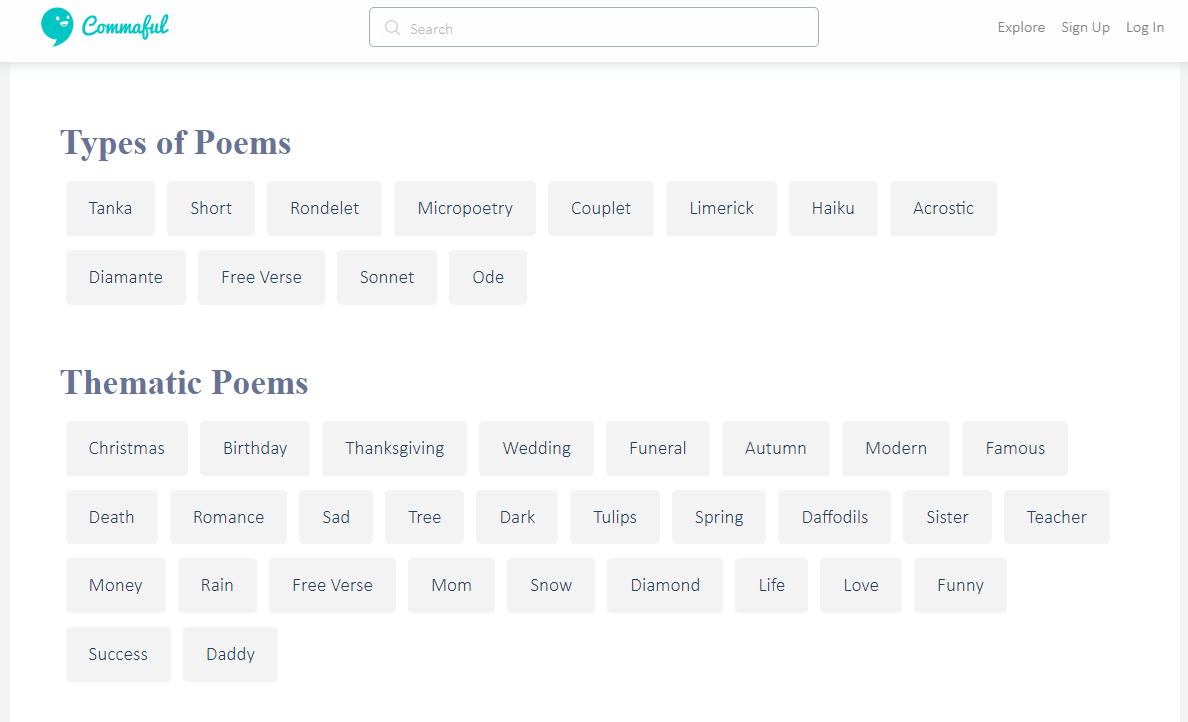
Commaful stories are told in a picture-book format. If you want to experiment with the visual representation of your poems, this is the platform for you.
Commaful is a friendly community that can help you get a start in self-publishing poetry, but it has a smaller reach than most of the other sites.
HelloPoetry
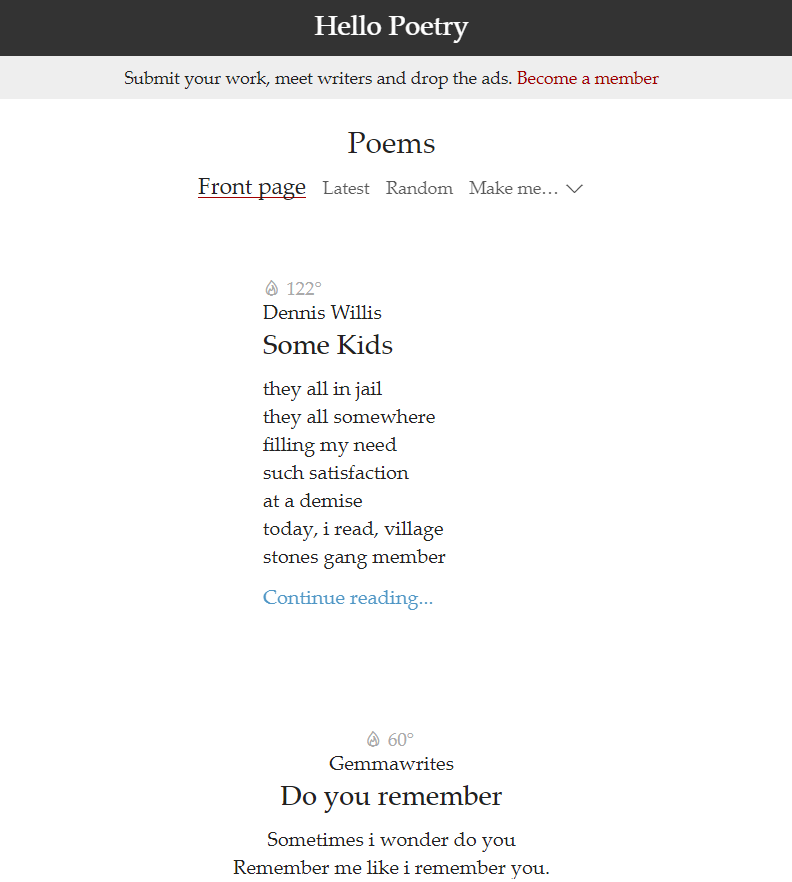
When opening HelloPoetry, you might feel like you are flipping through an anthology of poetry with a modern flare.
You can only join this community via invitation, making it a smaller but professional site.
Aside from sharing your own work, you can browse other poems and share them on your profile page. If you want to chat with fellow poets about writing style and inspiration and get constructive feedback to help you in the publishing industry, you can apply for an invitation and submit your work.
AllPoetry
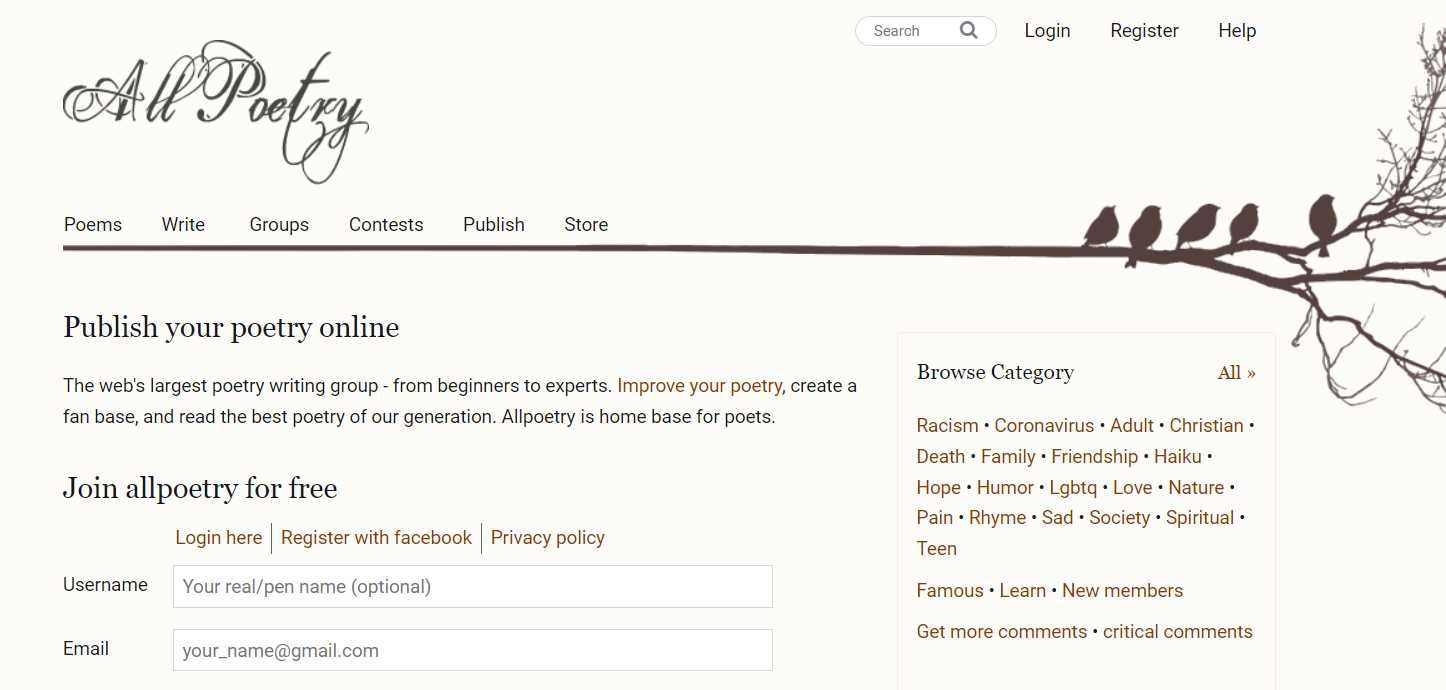
“Allpoetry is home base for poets.” Here, you’ll be able to join writing contests as well as online courses to improve your writing and get ready for self-publishing your poetry.
Goodreads
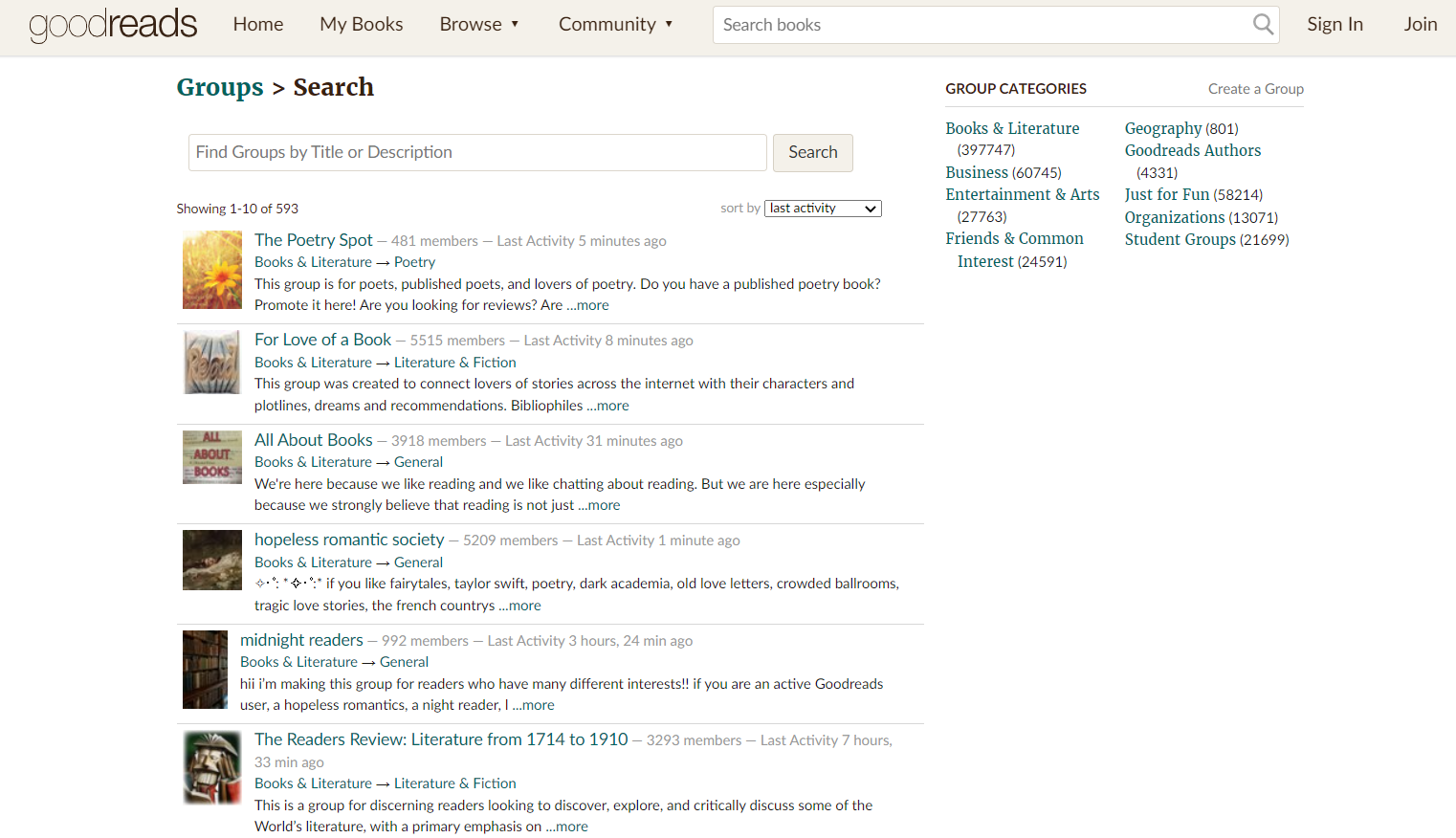
There are many writing communities on Goodreads, which you can join and build a following. Moreover, once you publish your book, you can set up giveaways and promote them on social media to encourage people to enter the contest and get your book.
2. Edit your poetry book
After sharing your poems on the platforms of your choice, there’ll be a moment when you have enough to gather into a volume.
Then comes the editing part. You have to determine:
- the themes that connect the poems together;
- the order of your poems;
- whether you’d like to separate your volume into parts or you’d like the poems to flow after one another without a break.
After editing, you’ll see that not all of your existing poems fit your chosen theme. But you can include them in your next book of poetry.
3. Plan the layout for your poetry book
The way you arrange your poems on the page is also important, especially for short poems; each word can have a powerful impact.
For that to happen, you must leave enough white space on the page. It is generally recommended not to have more than one poem on each page of your book of poetry.
Also, you can play around with making shapes out of the words creating an extra layer of meaning to your work and leaving a strong visual impression on your reader.
4. Look into cover design and illustration
Not only your cover design but also the illustrations you use in your poetry book can enhance your poems and the book’s aesthetics.
Some of today’s poets (see Rupi Kaur) include their own designs. Other published poets choose to collaborate with an illustrator.
If you choose to work with an illustrator, make sure that their style matches your writing.
If you want to find an illustrator, you can:
- Ask around your writing group whether someone can recommend you one.
- Go on these websites and look at portfolios of illustrators: Behance, Directory of Illustration, and Workbook.
- Post your requirements on freelance websites such as Upwork or Guru, and wait for illustrators to start sending their offers.
5. Search for a publisher or go on the self-publishing route
When deciding to publish your book, you can choose traditional publishing or self-publishing. If you want to go with traditional poetry publishers, you’ll have to start looking for agents to represent you.
Self-publishing, however, is perfect for those who want to take complete control of the publishing process. The independent author route will bring them creative freedom, more royalties, and the ability to publish their poetry book whenever they want.
Here’s how to self-publish a poetry book.
How to Self-Publish Poetry
Choosing the self-publishing option means you’re ready to take over the entire publishing process.
You’ll have to:
- Edit your manuscript or hire a professional editor;
- Design a book cover or hire a designer;
- Format your manuscript;
- Choose a self-publishing company (there are self-publishing sites where you can publish poetry for free)
PublishDrive is an aggregator that helps indie authors and publishers with self-publishing ebooks, audiobooks, and print-on-demand books to thousands of stores worldwide.
With PublishDrive, your book can reach international audiences, including hard-to-reach markets like China. Besides the stores from where readers can buy your book, you can also distribute to subscription-based platforms for those readers who prefer to read poems like that.
The process of self-publishing a poetry book with PublishDrive is very simple:
Step 1: Create an account.
Step 2: Choose the book format and upload your book to the platform from Dashboard > My Books.
Step 3: Fill out the details.
Note: If you wish to set up a pre-order period, you can do this when you reach the Rights section. Choose Else and the publication date.
Step 4: Select the distribution.
Step 5: Publish your poetry book.
Note: After publishing, once you earn royalties, you’ll start seeing those payouts after two months (although it could be longer, depending on the reporting and payment cycles of the different stores.)
💡Read everything you need to know about self-publishing a book in our guide.
Let’s see how to promote your poetry book.
How to Promote Your Book with PublishDrive
Now you know how to publish poetry in just a few steps. However, if you choose to self-publish your poetry book, you need to promote it using a well-defined marketing strategy.
To enhance the marketing for your poetry book, PublishDrive has a few features and partnerships with popular stores and websites.
After you self-publish your poetry book, go to the Promotions tab from PublishDrive’s dashboard and choose the kind of promotion you want to use.

Here’s what you can find on the platform.
Paid promotions
1. Amazon advertising
Generate more sales with Amazon ads, as your books will be displayed to shoppers who actively search for products on Amazon.
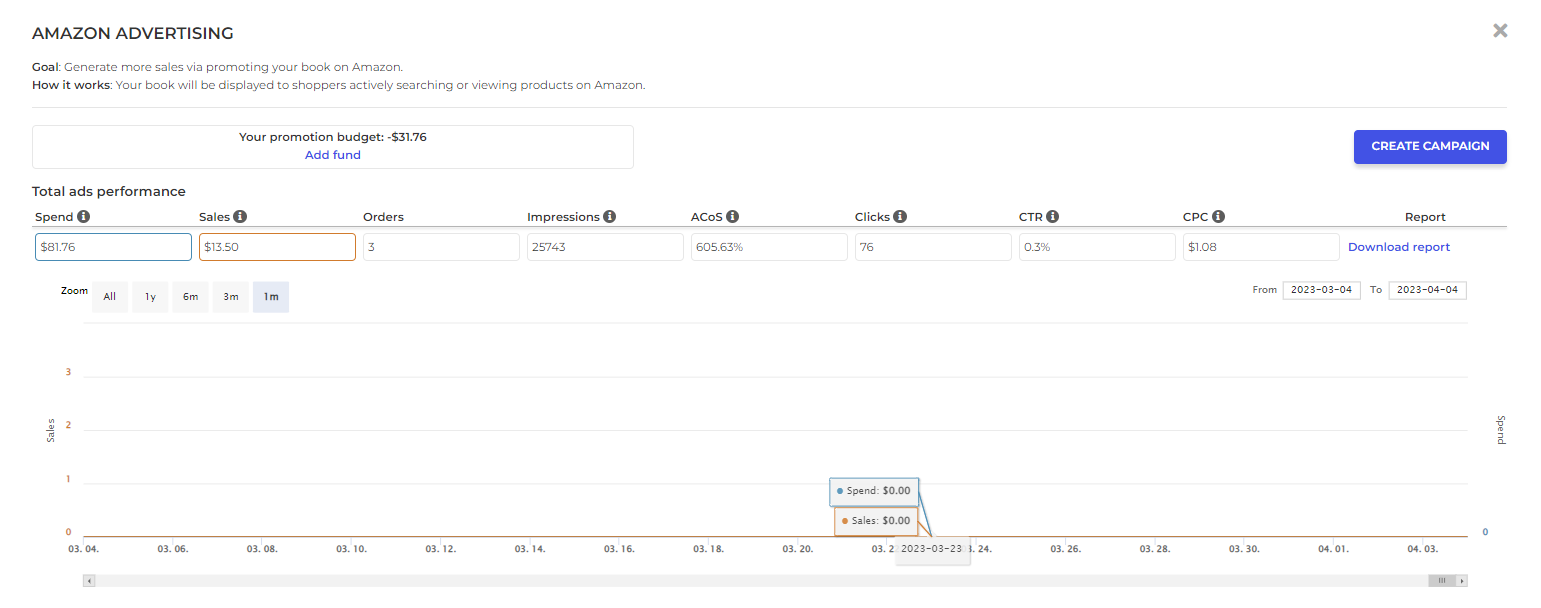
PublishDrive has a built-in marketing tool that manages Amazon’s Sponsored Products ads directly. It uses AI to identify the most relevant products to target and helps you optimize your ads with four options:
- Automatic targeting. Amazon matches your ad with relevant keywords and products similar to your book.
- Manual keyword targeting. Choose the keywords you want to target.
- Product targeting. Target specific products to refine your ad campaign.
- Negative keywords. Exclude keywords to prevent irrelevant traffic that drives up costs.
2. Drive book sales (partnership with Written Word Media)
Authors can promote and reach thousands of readers interested in a specific genre.
We’ve partnered with Written Word Media, a platform for self-published authors that has multiple book promotion sites:
- Freebooksy: for titles that are always free or free for a limited time;
- Bargain Booksy: for titles that are priced at $4.99 or below;
- Red Feather Romance: for romance titles that are free or regularly priced;
- NewInBooks: for titles released in the past 60 days.
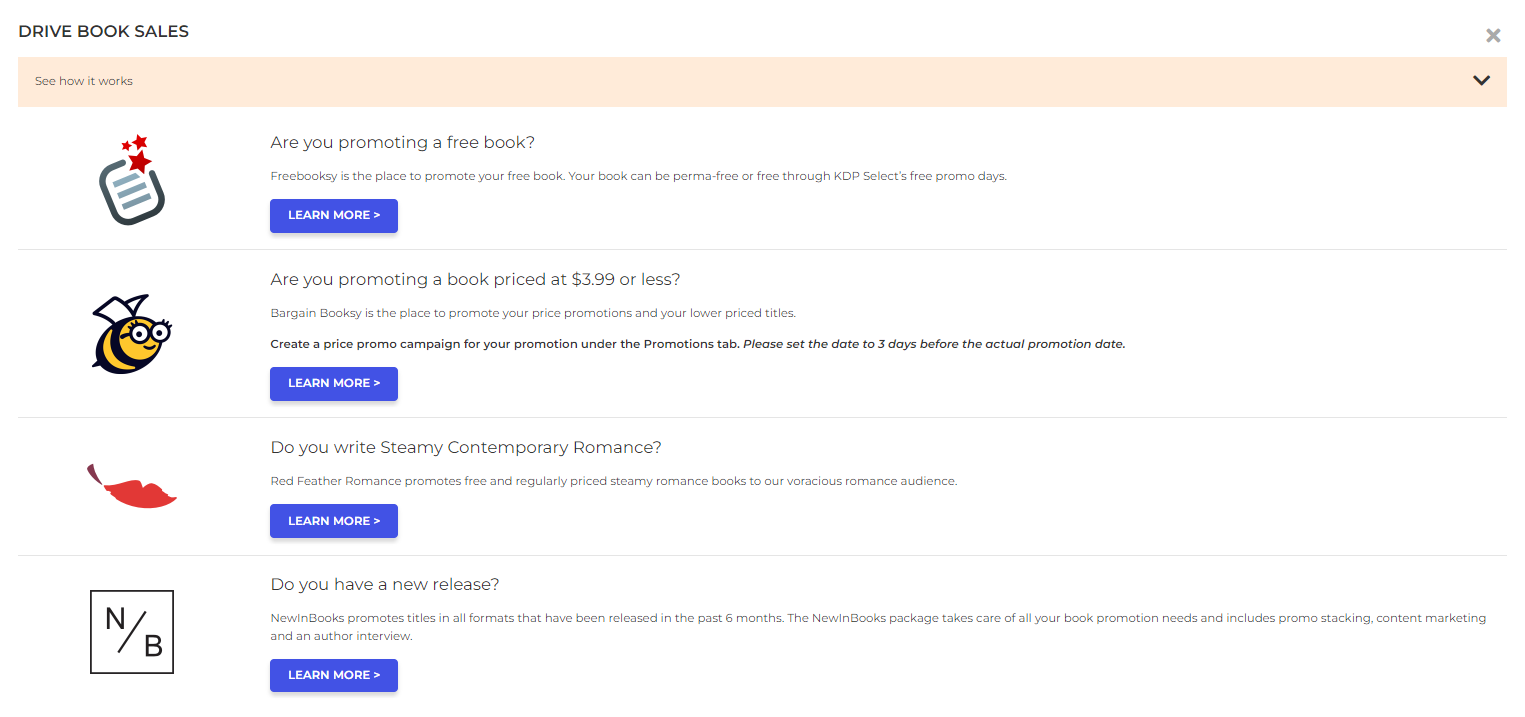
How to book your promotion
Step 1: Choose a suitable promotional site that caters to your book's genre.
Step 2: You will be redirected to Written Word Media, where you’ll enter your book information.
Step 3: To create a price promotion campaign, go to the Promotions tab on the PublishDrive dashboard and select a start date. Make sure to set the date to three days before the promotion date.
Note: Promotions start at $25. Pricing is based on the size of the audience and the results.
Advanced promotions
1. Price promotion
Schedule price promotions for your book straight from PublishDrive’s dashboard.
You can set price promotions in the following retailers:
- Amazon
- Apple Books
- Kobo
- Barnes & Noble
- Google Play Books
To create and run a price promotion, you need a published title that’s available in the retailers mentioned above.
Note: You can modify your promotion up to three days before it starts, as the promotional prices will be made available to retailers on the start date you have specified, at the latest. Certain retail stores like Barnes & Noble and Amazon may offer the promotion a day earlier than planned.
After the price promotion ends, your original prices may take one or two days to be re-set.
2. Review copies
Send review copies to book reviewers using promotion codes. You can also send review ebooks for promotional purposes to some popular stores (currently in Apple Books and Google Play Books).
These are protected copies available for 28 days that cannot be forwarded or copied beyond the intended recipient. For more info, please read our article about review copies.
3. Featuring
With the Featuring tab, authors can promote their books for free. Here’s how it works:
- PublishDrive's merchandiser selects a title that gets featured. PublishDrive recommends titles to editorial teams of retailers and book promotional platforms, who then select books for special features. You should receive emails for these opportunities if you have eligible titles.
- Authors can use the Featuring tab directly to nominate their books. Keep in mind that this is not a guaranteed deal. PublishDrive’s editorial team picks the best stories to tell.
Where can you promote your book using the Featuring tab?
- Written Word Media websites & newsletters
- Dreame
- Apple Books
- Bibliotheca
- Hoople
- 24symbols
You should select titles that align with the specific theme of the promotion.
5. Social media
PublishDrive is eager to showcase success stories from our community on our social media channels. Simply inform us of your news, and we'll gladly promote it through our social channels.
Final Thoughts
From finding your unique voice to learning how to publish poems and marketing your poetry book, there are many important factors to consider along the way.
Take the time to research and understand the publishing landscape and build a strong online presence. This will help you greatly when you decide to start publishing poetry.
And keep in mind that PublishDrive is here to help you self-publish your poetry book.